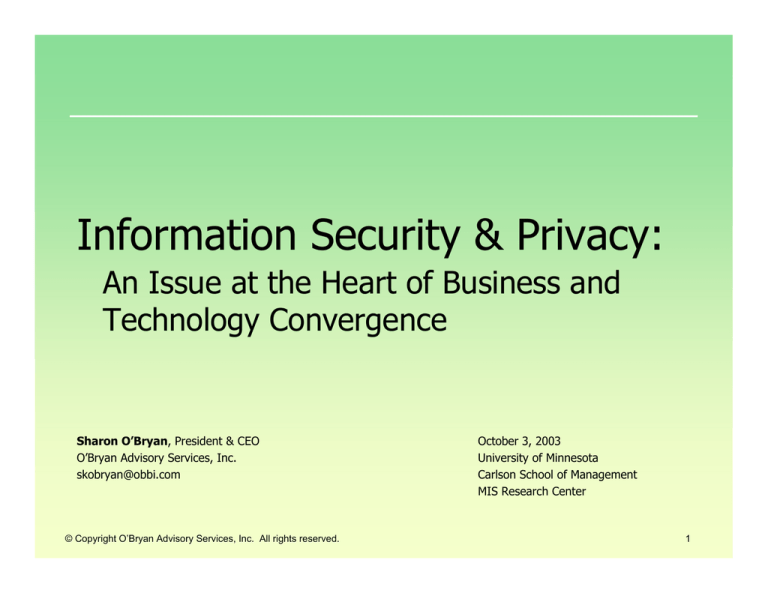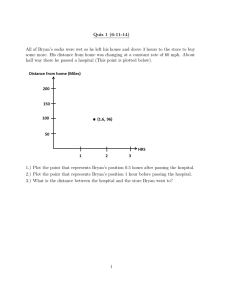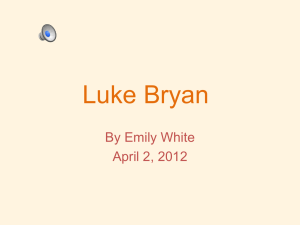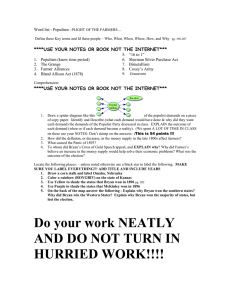
Information Security & Privacy:
An Issue at the Heart of Business and
Technology Convergence
Sharon O’Bryan, President & CEO
O’Bryan Advisory Services, Inc.
skobryan@obbi.com
© Copyright O’
O’Bryan Advisory Services, Inc. All rights reserved.
October 3, 2003
University of Minnesota
Carlson School of Management
MIS Research Center
1
Agenda
8:30 – 9:30
9:30 – 9:40
9:40 – 11:00
© Copyright O’
O’Bryan Advisory Services, Inc. All rights reserved.
Open
Introductions
Goals
Privacy Foundation
Break
Security Foundation
G-L-B-A Key Points
HIPAA Key Points
Summary
2
Introductions
© Copyright O’
O’Bryan Advisory Services, Inc. All rights reserved.
3
Seminar Participants
Name
Company
Responsibility for Privacy/Security
Exposure to technology aspects of
Privacy/Security
Goal
© Copyright O’
O’Bryan Advisory Services, Inc. All rights reserved.
4
Goals
© Copyright O’
O’Bryan Advisory Services, Inc. All rights reserved.
5
Goals
Explore privacy issues from multiple perspectives
Establish a mental framework to create solutions to
reduce privacy exposures
Understand technology-induced exposures to privacy
Understand requirements as prescribed by the GrammLeach-Bliley Act 501(b)
Understand requirements as prescribed by the Health
Insurance Portability and Accountability Act of 1996
Realize applicability to participants through hypothetical
case studies
Explore privacy matters from multiple perspectives:
– Citizens
– Business Leaders
– Investors
© Copyright O’
O’Bryan Advisory Services, Inc. All rights reserved.
6
Privacy Foundation
© Copyright O’
O’Bryan Advisory Services, Inc. All rights reserved.
7
Privacy in Context
Industry
Company/Business
Within the context of G-L-B-A
– Sec. 501
• “…customer’s non-public personal information”
Within the context of HIPAA
– Standards for Privacy of Individually Identifiable
Health Information
• Protecting the privacy of health information given the rapid
evolution of health information systems in the Health
Insurance Portability and Accountability Act of 1996
Collection, Use and Disclosure of Personal
Information
© Copyright O’
O’Bryan Advisory Services, Inc. All rights reserved.
8
High Level Considerations
Operationally
– Transaction
–
–
–
–
–
• Documents
• Printouts
• Verbal Communication
Customers
Business Partners
Vendors
Consultants
Auditors
Transaction Flow Diagram is
essential to ensuring consistent,
end-to-end, protection of information
© Copyright O’
O’Bryan Advisory Services, Inc. All rights reserved.
Technically
– Transaction
• Creation
• Maintenance
– Network traversing
– Application
– Database
• ALL Platforms
– Storage
•
•
•
•
•
Temporary Storage
Backups
Diskettes
CDs
PCs
9
Group Participation
Applying for a mortgage
–
–
–
–
–
–
© Copyright O’
O’Bryan Advisory Services, Inc. All rights reserved.
10
Group Participation
Taking a STD Leave from work
–
–
–
–
–
–
–
© Copyright O’
O’Bryan Advisory Services, Inc. All rights reserved.
11
Group Participation
Changing your health insurance to add a
new family member
–
–
–
–
–
–
–
© Copyright O’
O’Bryan Advisory Services, Inc. All rights reserved.
12
Group Participation
Obtaining a life insurance policy (external
to your employer)
–
–
–
–
–
–
–
© Copyright O’
O’Bryan Advisory Services, Inc. All rights reserved.
13
Group Participation
Charging a purchase at a store
–
–
–
–
–
–
–
© Copyright O’
O’Bryan Advisory Services, Inc. All rights reserved.
14
Group Discussion Summary
What are your concerns as a consumer
How do they apply to your company?
© Copyright O’
O’Bryan Advisory Services, Inc. All rights reserved.
15
Information Assets & Rights
Consumer
– What do you consider your
personal and confidential
–
–
–
–
information?
Who has it?
What are your expectations
around “the custodian’s”
control of it?
How do you verify
compliance?
What information do you
expect to be shared to enable
service offerings to you?
© Copyright O’
O’Bryan Advisory Services, Inc. All rights reserved.
Business
– How has your business
identified customer
confidential/critical
information?
– How has your business
identified critical corporate
information?
– How does your business
identify this information?
– How are employees expected
to handle this information?
– How does the management
verify employees are aware
and capable of delivering
upon expectations?
16
Update Risk Assessment
The value of the information drives the risk
Business operations executives are guardians, or
owners, over information & define the
classification to be assigned to the information
within the context of risk
The classification drives the access, handling,
marking, retention, audit trail, and investment
associated with the information
© Copyright O’
O’Bryan Advisory Services, Inc. All rights reserved.
17
Risk Assessment Process
General Information
– Project View
– Business Process View
Information Classification
Business Continuity Classification
Resource Classification
© Copyright O’
O’Bryan Advisory Services, Inc. All rights reserved.
18
Information Classification
“Unrestricted”
– Information generally known; no marking or special
handling required.
“Restricted”
– Information has proprietary value; must be marked
and available only to those authorized to execute
related transactions
“Confidential”
– Information with significant proprietary value with
relatively minimal distribution need; access logged
Now think about this from a consumer’s view!
© Copyright O’
O’Bryan Advisory Services, Inc. All rights reserved.
19
General Information
From a PROJECT perspective, the Project Manager would be responsible
for the completion of this section.
1.
GENERAL/PROJECT INFORMATION
Project Name:
Project #:
Business Case #
CORP#:
RC#:
Approved Date:
Start Date:
Expected Production Date:
Executive Sponsor:
Phone:
Business Owner:
Phone:
Project Manager:
Phone:
IT Application Owner:
Phone:
CRM Representative:
Phone:
Project Description:
© Copyright O’
O’Bryan Advisory Services, Inc. All rights reserved.
20
General Information
From a Business Process perspective, the Business Owner would be
responsible for the completion of this section.
1.
GENERAL/PROJECT INFORMATION
Business Transaction Description:
Division/Department Name:
CORP#:
RC#:
Division Executive Print/Signoff:
Name:
Sign:
Business Owner Print/Signoff:
Name:
Sign:
Date:
Key Data Field 1:
Employee Role:
Access Level:
Data Field 2:
Employee Role:
Access Level:
Data Field 3:
Employee Role:
Access level:
Customer Service Level Description:
Regulatory Implications:
© Copyright O’
O’Bryan Advisory Services, Inc. All rights reserved.
21
Information Classification
The Business Owner is responsible for the completion of this section.
2.
INFORMATION ASSET CLASSIFICATION
Instructions: Using the definitions provided, check only ONE box on each row to indicate the highest level of risk appropriate to the information
assets affected by this project. Provide justification for your selection.
NOTE: An incident is defined as a harmful event such as unauthorized modification of data, inappropriate disclosure of information, or
unavailability of information or information systems.
ATTRIBUTE / CLASSIFICATION
UNRESTRICTED
An incident affecting the
information asset may cause
little or no damage to the
company.
RESTRICTED
An incident affecting the
information asset may cause
significant damage to the
company.
CONFIDENTIAL
An incident affecting the
information asset will probably
cause substantial damage to the
company.
RELIABILITY
The business requirement to have
accurate, complete, and timely
information.
Justification for Reliability Classification:
AVAILABILITY
The business requirement to access
the information at specific times.
Justification for Availability Classification:
CONFIDENTIALITY
The business requirement to protect
information against unauthorized
disclosure, whether accidental or
deliberate.
Justification for Confidentiality Classification:
© Copyright O’
O’Bryan Advisory Services, Inc. All rights reserved.
22
Business Continuity Classification
The Business Owner is responsible for the completion of this section.
3. BUSINESS CONTINUITY CLASSIFICATION
Instructions: Check only ONE box on each row to indicate the impact on the customer, operations, and regulatory or
legal requirements if the application or function were interrupted once this project is implemented. THIS MATRIX DOES
NOT REPLACE THE BIA; it is intended to bring business continuity issues to light during the early stages of the project.
For more information, contact the Business Continuity Planning and Technology Recovery group of Technology Risk
Management.
BUSINESS IMPACT
What would be the impact in terms of loss of productivity, revenue or reputation if the
applications/functions related to this project were not available or could not be
performed?
IMPACT OF DISRUPTION
HIGH
MEDIUM
LOW
DATA LOSS
What would be the impact of in terms of loss of productivity, revenue or reputation if
key data were lost or unrecoverable?
TIME SENSITIVITY
What would be the maximum amount of time the function/application could be
unavailable given the Business Impact identified above?
High: 2 hours or less
Medium: 2 – 48 hours
Low: 48 hours or more
INTERACTIONS
What would be the impact if key business partners (internal/external) were unable to
conduct their end of this process?
© Copyright O’
O’Bryan Advisory Services, Inc. All rights reserved.
23
Resource Classification
The IT Application Owner is responsible for the completion of this section
(depicted from Project Perspective)
4. RESOURCE IDENTIFICATION
Instructions: Indicate all the platforms required by checking as many boxes as apply. Specify the location for each
platform. Check NEW to indicate that the project will require a new server or other addition to the technology
infrastructure.
PLATFORM
NEW
INTERNAL TO COMPANY
YES
NO
LOCATION(S)
EXTERNAL TO COMPANY
YES
NO
LOCATION(S)
SYSTEM
BACKED UP
YES
NO
Mainframe
Tandem
AS400
RS6000
Sun
HP
Intel
Other
(specify)
© Copyright O’
O’Bryan Advisory Services, Inc. All rights reserved.
(specify)
24
Transaction Flow
The IT Application Owner is responsible for the completion of this section.
5.
INTERFACES AND OTHER REQUIREMENTS
Instructions: Check as many boxes as apply to indicate connectivity and transaction flow information.
DESCRIPTION
INTERNAL
EXTERNAL
DESCRIPTION
FTP
NDM
MQ
WOLF
Web - JAVA
Web – ActiveContent
Remote Access
Gateway
Wireless
Encryption
Firewall
Other (specify)
Other (specify)
Other (specify)
© Copyright O’
O’Bryan Advisory Services, Inc. All rights reserved.
INTERNAL
EXTERNAL
25
Privacy Evolving
Privacy expectations changing
The “opt out” debacle
- Consumer study
© Copyright O’
O’Bryan Advisory Services, Inc. All rights reserved.
26
BREAK
Please be back in
10 Minutes
© Copyright O’
O’Bryan Advisory Services, Inc. All rights reserved.
27
Security Foundation
© Copyright O’
O’Bryan Advisory Services, Inc. All rights reserved.
28
Start With Basics
Reliability
the business need to
have accurate, complete and timely
information
data
application
Confidentiality the business
need to maintain customer
information, privacy, and corporate
information confidentially
system
authentication
network
process
AVAILABILITY
the business
need to have information available
when required
compliance, policies & standards
business strategy
mission
Consider: Authorized User Passwords remain the weakest link!
© Copyright O’
O’Bryan Advisory Services, Inc. All rights reserved.
29
IT Security Components
Security Architecture
Network Security
Security Operations
Access Provisioning
IT Risk Reporting & Compliance
© Copyright O’
O’Bryan Advisory Services, Inc. All rights reserved.
30
Security Architecture
End-to-End Requirements Analysis
Risk Assessment Lead
Pertinent technology research
Active vendor interaction
Pertinent Policies, Standards, Guidelines
leadership
© Copyright O’
O’Bryan Advisory Services, Inc. All rights reserved.
31
Network Security
Vulnerability Management
Network Perimeter Security
Incident Response Leadership
© Copyright O’
O’Bryan Advisory Services, Inc. All rights reserved.
32
Security Operations
Authentication
Cryptography
Client Server Security
Mainframe/Tandem Security
Unix Security
– Unix
– NT
© Copyright O’
O’Bryan Advisory Services, Inc. All rights reserved.
33
Access Provisioning
Access Enablement
ID Assignment & Password Reset
© Copyright O’
O’Bryan Advisory Services, Inc. All rights reserved.
34
IT Risk Reporting & Compliance
Compliance
Monthly Status Reporting
Outsourcing Relationship Tracking
Awareness
Audit/Log Reporting
Human Resource Coordination
– Related HR Policy Issues
• The case of the “Porn King”
© Copyright O’
O’Bryan Advisory Services, Inc. All rights reserved.
35
Some Leadership Points
Tracking and reporting on progress
“Security” (and Contingency Planning) are no
longer a small budget item
Senior IT security management must have skills
to:
–
–
–
–
–
–
Develop business cases
Manage projects
Manage budgets
Present to Board Members
Proactively identify & take action on evolving issues
Participate & lead industry groups
© Copyright O’
O’Bryan Advisory Services, Inc. All rights reserved.
36
Email – A Point on Security
Don’t assume privacy
You would be surprised at the business transactions
done via email!
– Lab results
– Trade confirmations
– Home mortgage loan and other financial account changes,
inquiries, complaints, etc.
Employee harassment via anonymous email
– AN ACTUAL SET OF INCIDENTS (no details in handout)
Now, let me introduce you to Andre Bacard…
© Copyright O’
O’Bryan Advisory Services, Inc. All rights reserved.
37
© Copyright O’
O’Bryan Advisory Services, Inc. All rights reserved.
38
© Copyright O’
O’Bryan Advisory Services, Inc. All rights reserved.
39
G-L-B-A Key Points
© Copyright O’
O’Bryan Advisory Services, Inc. All rights reserved.
40
Gramm-Leach-Bliley-Act
Public Law 106-102
November 12, 1999
Three Fundamental Financial Services Changes
– Repeals key provisions of Glass Steagall Act
permitting commercial banks to affiliate with
investment banks
– Substantially modifies the 43-year old Bank Holding
Company Act of 1956 permitting companies that own
commercial banks to expand services of financial
activity
– Allows bank subsidiaries to engage in broad range of
financial activities that are not permitted for banks
themselves
© Copyright O’
O’Bryan Advisory Services, Inc. All rights reserved.
41
Gramm-Leach-Bliley-Act
Other Important Provisions
– Eliminates the authority of commercial
companies to acquire thrift institutions
through the unitary thrift holding company
vehicle
– New provisions regarding privacy of customer
information
– Increased access by community banks to the
Federal Home Loan Bank System
– Significantly changes the requirements
imposed by the Community Reinvestment Act
© Copyright O’
O’Bryan Advisory Services, Inc. All rights reserved.
42
G-L-B-A Key Effective Dates
Title I – Affiliations
Title II – Securities
Title III – Insurance Regulation
Title IV – Unitary Thrift Holding Companies
Title V – Privacy
Title VI – Federal Home Loan Bank System
Reforms
Title VII – Miscellaneous Regulatory Provisions
© Copyright O’
O’Bryan Advisory Services, Inc. All rights reserved.
43
Focused G-L-B-A Discussion
Title V – Privacy
–
Financial Institutions Must
1. Establish and Annually Disclose Privacy Policy
2. Provide consume right to prevent disclosure of nonpublic
personal information to a nonaffiliated third party (“opt
out”)
3. Prohibits disclosure of account number, or equivalent
thereof, for use in telemarketing
4. Provision that “it is the policy of the Congress that each
financial institution has an affirmative and continuing
obligation to respect the privacy of its customers and to
protect the security and confidentiality of those customers’
nonpublic personal information”
© Copyright O’
O’Bryan Advisory Services, Inc. All rights reserved.
44
Significant Issues
Wording
– “policy of the Congress”
Effects of the privacy disclosures
“Opt out” debacle
© Copyright O’
O’Bryan Advisory Services, Inc. All rights reserved.
45
HIPAA Key Points
© Copyright O’
O’Bryan Advisory Services, Inc. All rights reserved.
46
1997
1996
HIPAA Time Line
August 21
September 11 U.S. Secretary of Health and Human Services (HHS) submitted a report to Congress recommending comprehensive
privacy legislation by August 21, 1999. The Secretary was directed to finalize regulations containing proposed
standards relating to electronic transfer of medical information by February 21, 2000 should congress fail to act by
the proposed 1999 date.
October 29
Congress was unable to reach consensus on comprehensive privacy legislation therefore the HHS Secretary took
action to finalize related regulations.
The Clinton Administration announced the proposed rules.
November 3
Proposed privacy standards were published in the Federal Register for public comment.
January 3
Initial deadline for privacy standards comment period. Deadline extended to February 17, 2000.
August 17
December 20
Final Transaction and Code Sets Final Rule Published.
Final regulations and compliance deadline released by the HHS Secretary. Initial deadline was February 26, 2003
but was later extended to April 14, 2003.
December 28
Final Privacy Rule published in the Federal Register.
July 6
December 27
HHS issued first guidance on privacy protections.
H.R. 3323, the Administrative Simplification Compliance Act (Public Law 107-105), signed in to law by President
Bush. Provides 1 year compliance extension for compliance with standard transactions and code set requirements.
March 27
Proposed changes to privacy standards published in the Federal Register
October 16
Transaction and Code Set compliance deadline unless extension request filed/accepted by DHHS by 10/15/02.
February 20
Final rule adopting standards for electronic PHI security published in the Federal Register.
April 14
Privacy standards compliance deadline for all covered entities except small health plans (less than $5M in annual
receipts).
October 16
Compliance deadline for Transaction and Code Sets.
April 14
Privacy standards compliance deadline for small health plans (less than $5M in annual receipts).
April 21
Electronic PHI Security Standards compliance deadline.
2003
2002
2001
2000
1999
August 21
2005 2004
Congress enacted the Health Insurance Portability and Accountability Act (HIPAA) requiring the Secretary of Health
& Human Services to propose standards to protect the privacy of individually identifiable health information by
August 21, 1997.
HIPAA
Public Law 104-191
August 21, 1996
General Objectives
– Assure health insurance portability by eliminating joblock associated with pre-existing medical condition
clauses
– Reduce fraud by enhancing detection capabilities
– Streamline paperwork through standardization
– Guarantee security and privacy of health information
© Copyright O’
O’Bryan Advisory Services, Inc. All rights reserved.
48
Other Concerns
Identity Theft
Terrorism
Technology Controls
– Implications, Capabilities, Limitations
Operation Controls
Operation/Technology control transition
Business Process Engineering
© Copyright O’
O’Bryan Advisory Services, Inc. All rights reserved.
49
Noteworthy
Outsourcing
MIS Test and QA Environments
Consultants and their equipment
Software vendor access to systems
– Remote
– On site
External Auditors
– Do they bring in their lap tops?
© Copyright O’
O’Bryan Advisory Services, Inc. All rights reserved.
50
Enabling Implementation
1. Identify Information Owners
2. Identify pertinent data
- Risk Assessment Process
3. Identify authorized access
- Role-based Access Provisioning
4. Ensure proper documentation of
transaction flow
5. Identify systems, applications, databases
that store/process/transport (item 2)
© Copyright O’
O’Bryan Advisory Services, Inc. All rights reserved.
51
Enabling Implementation
6.
7.
Identify control capability (operationally
and technically) – perform gap analysis
based upon requirements defined in
Risk Assessment
Prepare business case and submit via
proper channels
Note: Leadership is REQUIRED
© Copyright O’
O’Bryan Advisory Services, Inc. All rights reserved.
52
Summary
© Copyright O’
O’Bryan Advisory Services, Inc. All rights reserved.
53
What we have covered…
Explore privacy issues from multiple perspectives
Establish a mental framework to create solutions to
reduce privacy exposures
Understand technology-induced exposures to privacy
Understand requirements as prescribed by the GrammLeach-Bliley Act 501(b)
Understand requirements as prescribed by the Health
Insurance Portability and Accountability Act of 1996
Realize applicability to participants through hypothetical
case studies
Explore privacy matters from multiple perspectives:
– Citizens
– Business Leaders
– Investors
© Copyright O’
O’Bryan Advisory Services, Inc. All rights reserved.
54
Any Other Questions or Comments?
It has been a pleasure to meet with you.
Thank you for your participation.
Sharon O’Bryan
skobryan@obbi.com
(630) 762-0801
© Copyright O’
O’Bryan Advisory Services, Inc. All rights reserved.
55




